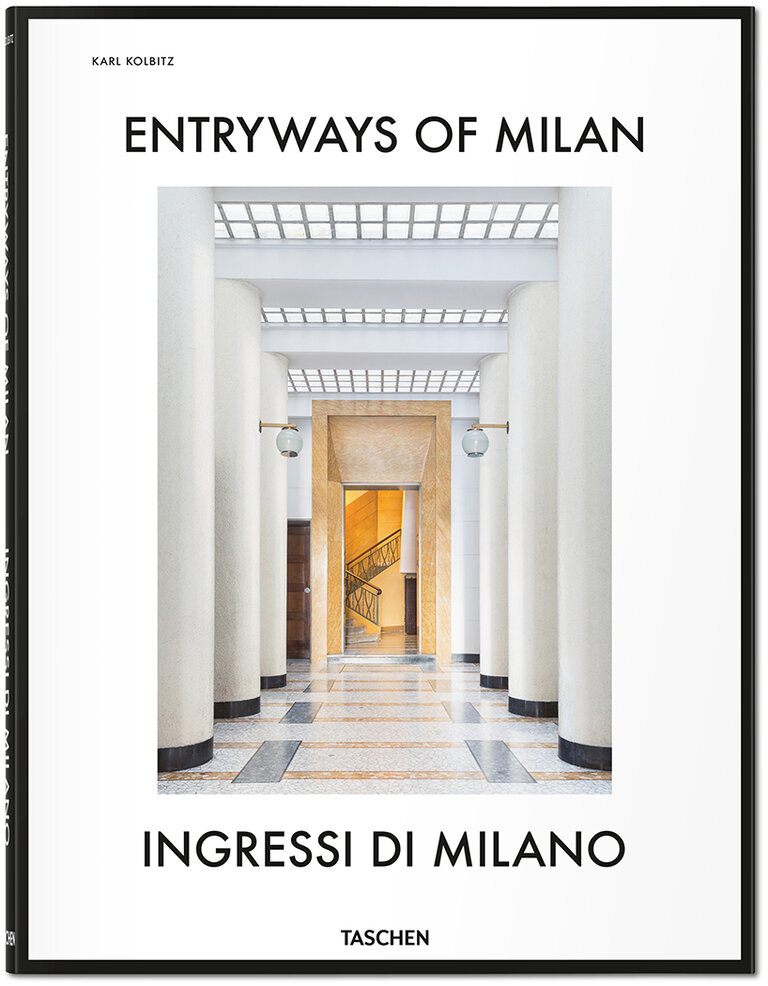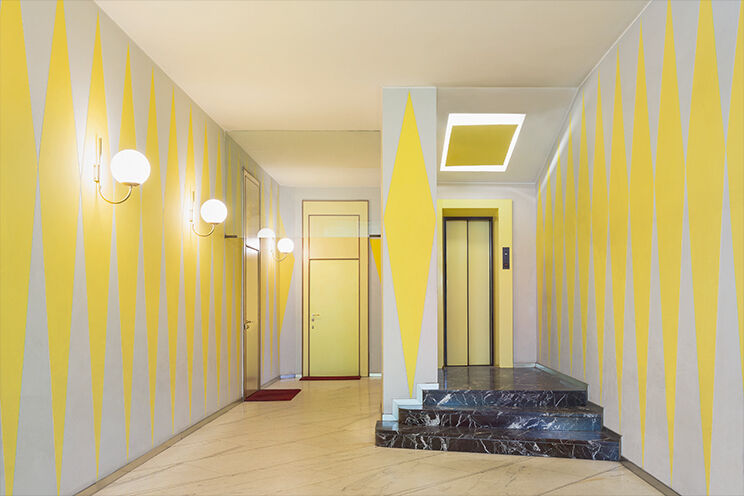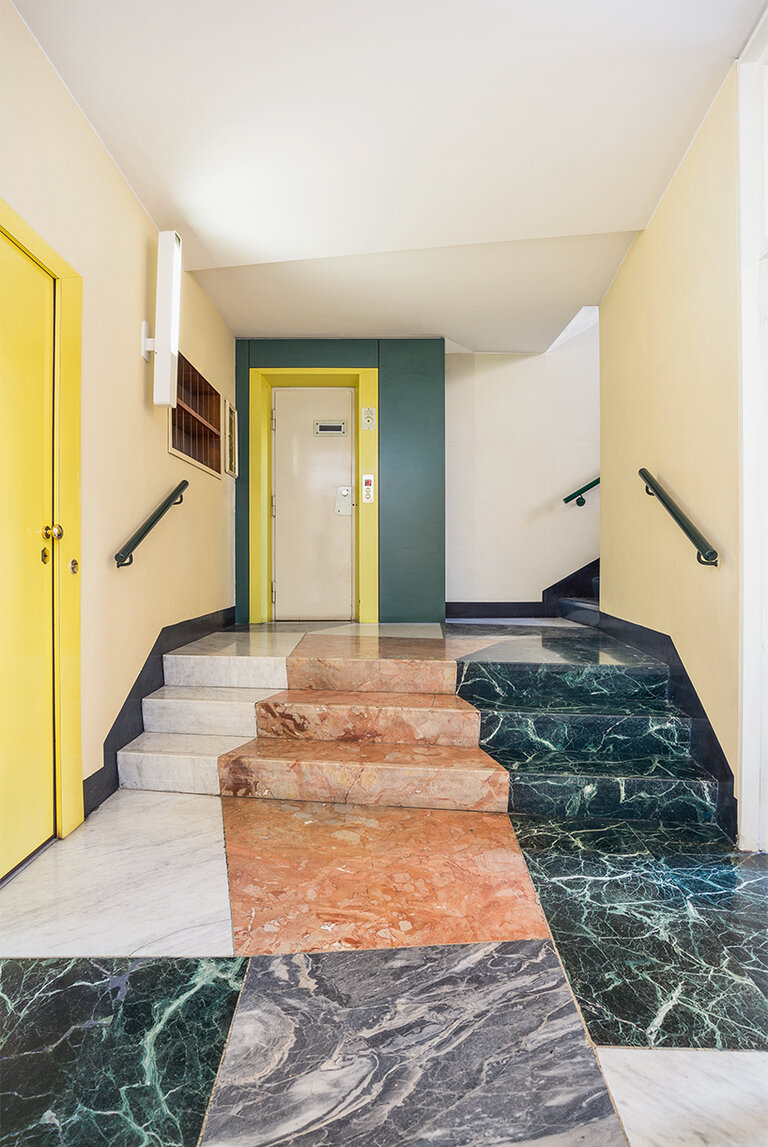

Valextra meets the Man behind Entryways of Milan, Karl Kolbitz
The Entryways of Milan editor and director talks us through his inspiration, his highlights and what makes Milan’s famous entryways utterly unique.

Karl Kolbitz didn’t know what he would find when he first embarked on his extensive research journey into his definitive tome, Entryways of Milan, nearly a decade ago. As a long-term aficionado of the city, the Berlin-born creative uncovered a unique microcosm of art and architecture that captures Milan’s ever beguiling juxtaposition between sobriety and spontaneity and presented it in detail never gone into before. Inspired by the same forces, Valextra shot the SS22 campaign in a selection of our favourite entryways and so for this month’s journal, Kolbitz was naturally top of our list to talk to. Here, he shares his unique insight into what makes these extraordinary entryways a joy to behold.
Valextra: Where did the inspiration for Entryways of Milan come from?
Karl Kolbitz: I’ve been coming to Milan for many years and was always in awe of the city. I’ve always thought that it was utterly beautiful because of its abundance of exciting architecture and design. It was during a walk at night when I realised that when its entryways are illuminated, they become way more present. When you look at them during the day, you can’t see the interiors spaces, yet when the world is dark outside you can look inside and see the depth through their glass windows; that’s when their power is unleashed! I looked into the subject and there had been nothing done. It had been mentioned as a side note in some architecture publications, but there was never a focus on them. The book was an idea that was born from a conversation with friends, architects, designers, and urban planners when we became aware of the phenomenon of entryways of Milan.
V: What makes this phenomenon so unique to Milan do you think?
KK: Milan’s beauty is not like Rome or Venice or Florence, it’s a different kind of beauty – it’s an acquired taste which is why it’s had a reputation as an ugly city for centuries. This beauty is captured perfectly by its entryways. The contrast between the inside and the outside, the private and the public, welcome and defence; they are buffer zones between one’s home and the outside world that capture Milan’s own juxtapositions. These spaces of synthesis – of architecture, design and art – had their peak in the post-war period when Milan really blossomed again, and artists and architects were collaborating on all sorts of projects. The punctuation of this was the entryways.
V: How was it received by the Milanese?
KK: It was incredible to see the feedback of the Milanese, they embraced this book so very much. My general experience of the Milanese is that they may be very discreet and reserved but they are open and welcoming people; they are curious, and they are interested. I heard from a lot of Milanese that the book filled them with a sense of pride and that was the biggest complement. The eye of a foreigner picks up on something familiar, but my concern was to do something that looked like it was made by an external eye. That’s why I collaborated with lots of Milanese contributors because it was so important to have that exchange.


V: What did this process look like?
KK: One way to do this would have been to pick 10 famous architects, of which there are many, and select 10 buildings and entrances of interest – but I didn’t want to do that. It would have been an expression of Milan, but it wouldn’t have reflected the real urban fabric. I wanted to depict the experience that I had, and that I believe is an experience that is shared with many others. It was an accessible vision, everything seen from the streets with no special access. This democratic approach is the thread that pulls itself through all my projects and anyone can visit these entrances. It’s not an interiors book about exclusivity or exclusive access - this is made from the street by walking. When you walk down any given street, you’ll be able to find entrances –beautiful, unusual, daring, some by prolific names and many where we don’t know who they are by.
V: There are 144 entrances featured in the book - how did you narrow it down?
KK: First, I looked at entryways of all kinds of buildings, not just residential buildings, but banks, schools, police stations and post offices in Milan that make you want to make a book about! There are, of course, the villas; Villa Necchi, for example, has this fabulous entry hall, but we focused on the condominiums. The variety in the world of entryways in Milan – not only in the book but the real world - is so vast. With the combination of wood, stone, metal, lighting, and artworks there is something for everyone. Some of them are really bizarre, so I tried to find a good balance of the beautiful, the odd, the strange, and the peculiar; beauty can be anything after all. Someone might like the combination of this stone and that marble and I might find it utterly appalling, something I find enticing you might shrug your shoulders at - it’s personal perception!
V: And how did you decide who to include?
KK: I didn’t want to only feature the famous architects, the Gio Pontis and Piero Portaluppis of the world. They’re certainly included, but we also selected a lot of buildings by architects who we didn’t know. We went into the city archive - an outstanding institution - to find the architects of certain addresses and try to find out who was behind the entryways. I basically went there to say I am working on a project and have 250 buildings to research and its brilliant director, Francesco Martelli, said let’s do it! It’s unusual for archives, because often they don’t like the extra effort because it means shifting a lot of documents. His openness was great because I didn’t have a publisher at the time – I presented Taschen with a thoroughly researched, full complete project!
V: That’s a bold move to do it without a publisher in place.
KK: I wanted to guard the project for a while because I thought a publisher might want to publish a bunch of beautiful pictures and get it out quickly, but I felt that if I was doing something like this, I had a responsibility to do it in a way I feel it is right and apply the level of research it ultimately has. It has the appeal of a beautiful coffee-table book, but it also goes beyond that. There’s an awful lot of information – every single detail is credited in the captions on each page and there are essays written by scholars in their field – such as Fabrizio Ballabio, Lisa Hockemeyer, Daniel Sherer and Penny Sparke – stone identification and commentary from the geologist Grazia Signori supported by Angela Ehling and design identification by Brian Kish who identified every handle, lamp, sconce, and chair featured. It is the first time this subject has ever been written about and I could never have done it without our team and of course all the people who I asked for advice and input to make sure it was shaped in the right direction.
I tried to find a good balance of the beautiful, the odd, the strange, and the peculiar; beauty can be anything after all
V: So, any favourites? Or is that an impossible question?
KK: Not favourites, but highlights for sure. One is Viale Tunisia 44. I love this one for its simplicity and its main feature, the glass and steel door to the back yard which gives a three-dimensional perspective in the space. You see this particular type of feature in a lot of places and entrances and it’s a direct reference to one of the most amazing historical places in Milan, a small little church just off the Duomo by Bramante – Chiesa di Santa Maria presso San Satiro. This church is outstanding for its tromp l’oeil backdrop. Another highlight that is easily viewed from the street is Palazzo Ina on Corso Sempione 33. This one is amazing for the combination of colours and materials – the floor is white marble Palladiana with pink grouting, the pillars are of pick-hammered concrete and then there are blue, white and pink mosaics on the wall. This building feels very unusual in the Milanese context, because it appears more like a housing block you might see in Sao Paolo, but the downstairs entrance is very Milanese.
V: What do you hope people take away with them from the book? A sense of appreciation and curiosity to discover the entrances themselves, perhaps?
KK: A lot these entryways are not listed and they are at the mercy of landlords. We like to hope a project like Entryways of Milan creates awareness, stimulates further research, and helps preservation efforts. It’s similar to the way Valextra is bringing attention to these entryways by choosing them as the backdrop to the new campaign. Indeed, Milan’s entryways are like stages and they are a spectacular setting to make an entrance!
Entryways of Milan is edited and directed by Karl Kolbitz and is published by Taschen.
Photo credits:
Matthew Billings
Entryways of Milan, edited by Karl Kolbitz
TASCHEN